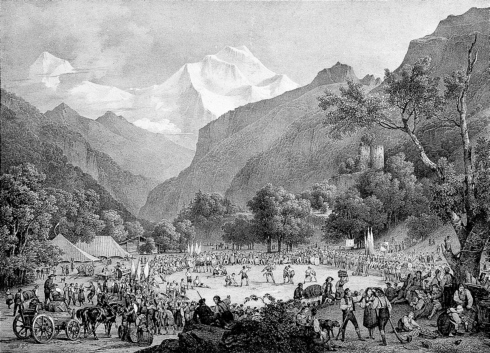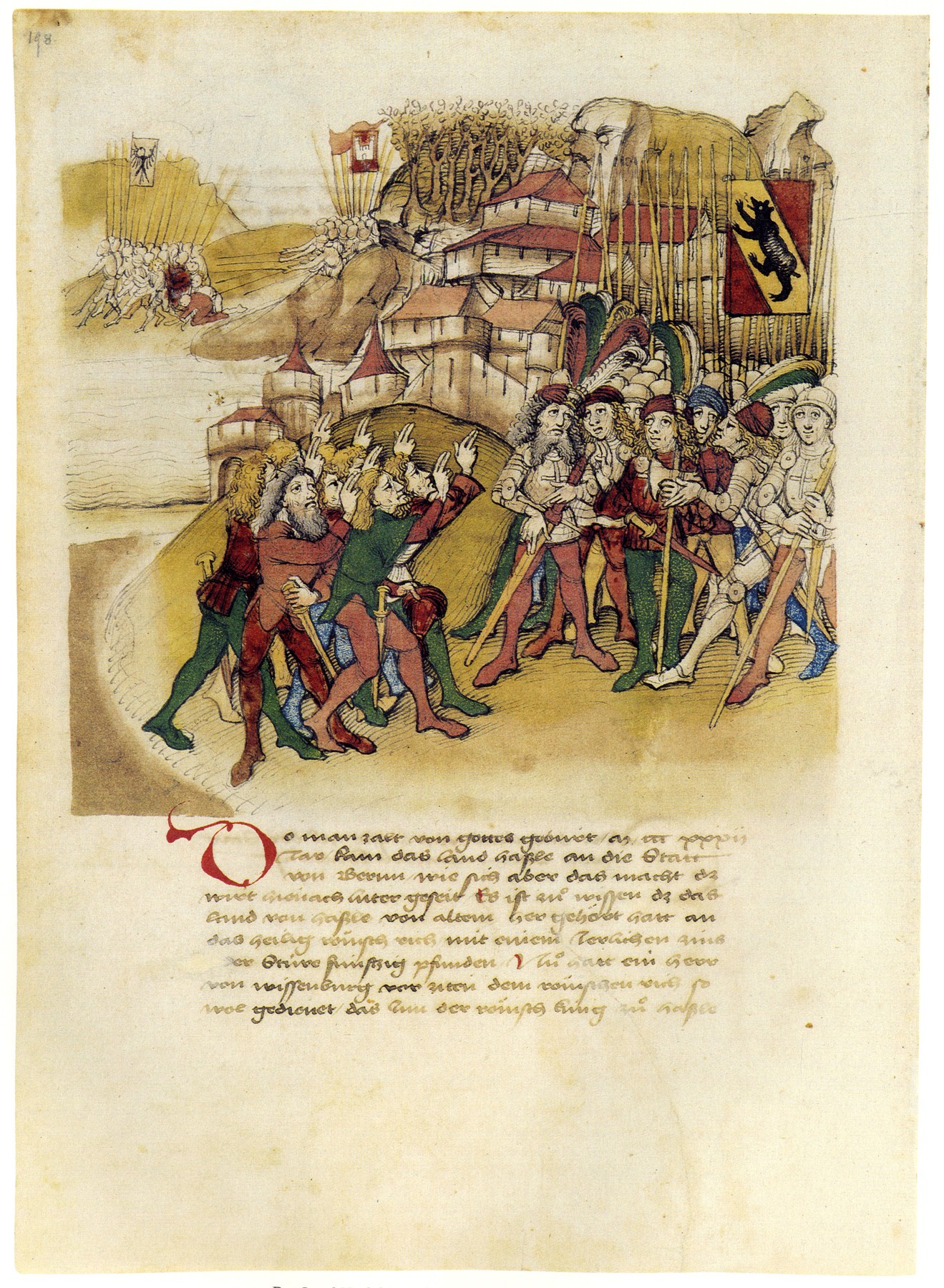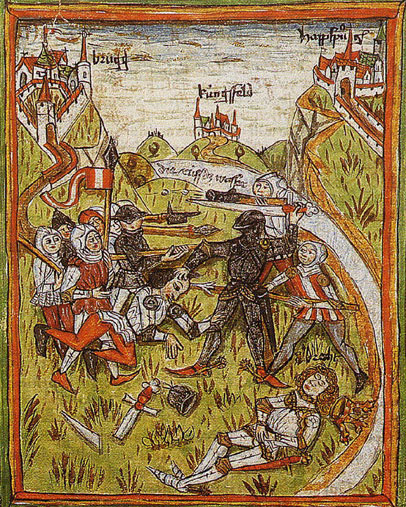|
Unspunnen Castle
Unspunnen Castle is a castle, now in ruins, located in the Municipalities of Switzerland, municipality of Wilderswil in the Bernese Highlands of Switzerland. The castle, likely constructed in the early 12th century, overlooks the city of Interlaken. Today, Unspunnen is home to ''Unspunnenfest'', a festival of traditional Swiss competitions held in the fields below the ruins. History The castle was the center of a 13th-14th century fief of an Bernese Oberland, Oberland barons, though the name of the barons or the castle builder is unknown. The cave castle of Rotenfluh (first mentioned in 1298 as ''munitio immersive balma Rothenfluo dicta'') at Tschingelsatz and Unspunnen Castle (first mentioned in 1232 as ''Uspunnun'') were used to guard the Late Middle Ages, late medieval ''Lütschinenbrücke'', a bridge at Gsteig bei Gstaad, Gsteig near Interlaken. In the 13th Century it belonged to the ''Herrschaft (territory), Herrschaft'' of Burkart of Thun, who acquired it through his 122 ... [...More Info...] [...Related Items...] OR: [Wikipedia] [Google] [Baidu] |
Wilderswil
Wilderswil is a village and a municipality in the Interlaken-Oberhasli administrative district in the canton of Bern in Switzerland. Wilderswil belongs to the Small Agglomeration ''Interlaken'' with 23,300 inhabitants (2014). Geography The village of Wilderswil is situated at the southern border of the Bödeli, the tongue of land between Lake Thun and Lake Brienz in the Bernese Oberland region. It lies at the entrance to the mountain valleys containing the Lütschine river and its tributary the Saxetenbach, and is some south of Interlaken, the main town of the Bödeli. The municipality extends for some from the village, along the west bank of the Lütschine river, and includes the flanks of the mountains that border that valley to the west. Its altitude ranges from some , on the Bödeli plain, to , at the summit of Sulegg. It consists of the villages of Wilderswil, Mülenen and Gsteigallmend. Wilderswil has an area of . Of this area, or 19.7% is used for agricult ... [...More Info...] [...Related Items...] OR: [Wikipedia] [Google] [Baidu] |
Herrschaft (territory)
The German term ''Herrschaft'' (plural: ''Herrschaften'') covers a broad semantic field and only the context will tell whether it means, "rule", "power", "dominion", "authority", "territory" or "lordship". In its most abstract sense, it refers to power relations in general while more concretely it may refer to the individuals or institutions that exercise that power. Finally, in a spatial sense in the Holy Roman Empire, it refers to a territory over which this power is exercised.Rachel Renaul "Herrschaft", ''Histoire du Saint-Empire'' The Herrschaft as a territory The ''Herrschaft'', whose closest equivalent was the French ''seigneurie'', usually translated as "lordship" in English, denoted a specific area of land with rights over both the soil and its inhabitants. While the lord ('' Herr'') was often a noble, it could also be a commoner such as a burgher, or a corporate entity such as a bishopric, a cathedral chapter, an abbey, a hospice or a town. Most lordships were ''medi ... [...More Info...] [...Related Items...] OR: [Wikipedia] [Google] [Baidu] |
Battle Of Sempach
The Battle of Sempach was fought on 9 July 1386, between Leopold III, Duke of Austria and the Old Swiss Confederacy. The battle was a decisive Swiss victory in which Duke Leopold and numerous Austrian nobles died. The victory helped turn the loosely allied Swiss Confederation into a more unified nation and is seen as a turning point in the growth of Switzerland. Background During 1383 and 1384, the expansion of the Old Swiss Confederacy collided with Austrian interests. The interests of Austria were further undermined in the Pact of Constance, a union of Zürich, Zug, Solothurn and 51 cities of Swabia. In 1385, there were various attacks, without formal declaration of war or central organization, by forces of Zürich, Zug and Lucerne on the Austrian strongholds of Rapperswil, Rothenburg, Cham and Wolhusen. In 1384 the people of Entlebuch receive the Lucerne citizenry and on Epiphany on the 6 January 1386, Lucerne expanded its sphere of influence by providing the same righ ... [...More Info...] [...Related Items...] OR: [Wikipedia] [Google] [Baidu] |
House Of Kyburg
The Kyburg family (; ; also Kiburg) was a noble family of ''grafen'' (counts) in the Duchy of Swabia, a cadet line of the counts of Dillingen, who in the late 12th and early 13th centuries ruled the County of Kyburg, corresponding to much of what is now Northeastern Switzerland. The family was one of the four most powerful noble families in the Swiss plateau (beside the House of Habsburg, the House of Zähringen and the House of Savoy) during the 12th century. With the extinction of the Kyburg family's male line in 1264, Rudolph of Habsburg laid claim to the Kyburg lands and annexed them to the Habsburg holdings, establishing the line of "Neu-Kyburg", which was in turn extinct in 1417. History Early history The first line of counts of Kyburg were influential in local politics during the 1020s, but the male line died out in 1078. Kyburg castle, southeast of Winterthur (in the modern canton of Zürich), passed on to the Swabian counts of Dillingen. Through the marriage of Har ... [...More Info...] [...Related Items...] OR: [Wikipedia] [Google] [Baidu] |
Battle Of Laupen
The Battle of Laupen was fought in June 1339, between Bern and its allies on one side, and Freiburg together with feudal landholders from the County of Burgundy and Habsburg territories on the other. Bern was victorious, consolidating its position in the region. As a consequence of the conflict, the relations of Bern and the Swiss Confederacy tightened, resulting in Bern's permanent accession in 1353. This is also the first battle that the white cross was documented as being used as a field sign worn by Swiss combatants. Background Prior to hostilities the free imperial city of Bern had undergone heavy expansion, however this expansion came at high expense to the feudal lords in the area and led to increasing competition with the neighbouring city of Fribourg. Bern had been allied with Fribourg since 1241, but Fribourg had been sold to the House of Habsburg in 1277. Fribourg entered a league with neighbouring feudal lords, including the County of Neuchâtel, the County of Savoy ... [...More Info...] [...Related Items...] OR: [Wikipedia] [Google] [Baidu] |
Bern
german: Berner(in)french: Bernois(e) it, bernese , neighboring_municipalities = Bremgarten bei Bern, Frauenkappelen, Ittigen, Kirchlindach, Köniz, Mühleberg, Muri bei Bern, Neuenegg, Ostermundigen, Wohlen bei Bern, Zollikofen , website = www.bern.ch Bern () or Berne; in other Swiss languages, gsw, Bärn ; frp, Bèrna ; it, Berna ; rm, Berna is the '' de facto'' capital of Switzerland, referred to as the "federal city" (in german: Bundesstadt, link=no, french: ville fédérale, link=no, it, città federale, link=no, and rm, citad federala, link=no). According to the Swiss constitution, the Swiss Confederation intentionally has no "capital", but Bern has governmental institutions such as the Federal Assembly and Federal Council. However, the Federal Supreme Court is in Lausanne, the Federal Criminal Court is in Bellinzona and the Federal Administrative Court and the Federal Patent Court are in St. Gallen, exemplifying the federal nature of the Confederati ... [...More Info...] [...Related Items...] OR: [Wikipedia] [Google] [Baidu] |
Oberhasli
The Oberhasli is a historical '' Landvogtei'' or ''Talschaft'' in the Bernese Highlands, Switzerland, bordering on the cantons of Obwalden (OW), Nidwalden (NW), Uri (UR) and Wallis (VS). From 1833 to 2009, Oberhasli was incorporated as the Oberhasli district, the easternmost of the 26 districts of the canton of Bern, bordering the district of Interlaken to the west. Since 2010, Oberhasli and Interlaken have been administratively united as the administrative district Interlaken-Oberhasli. The local dialect is of the Highest Alemannic variety. With its area of 551 km², it is larger than the canton of Basel-Landschaft. It consists of the six municipalities of Gadmen, Guttannen, Hasliberg, Innertkirchen, Meiringen and Schattenhalb, with a total population of just below 8,000, corresponding to a population density of less than 15/km2 (compared to a Swiss average of 181/km2), due to a significant portion of the area of Oberhasli being uninhabitable High Alps. Haslital is u ... [...More Info...] [...Related Items...] OR: [Wikipedia] [Google] [Baidu] |
Pledge (law)
A pledge is a bailment that conveys possessory title to property owned by a debtor (the ''pledgor'') to a creditor (the ''pledgee'') to secure repayment for some debt or obligation and to the mutual benefit of both parties. The term is also used to denote the property which constitutes the security. The pledge is a type of security interest. Pledge is the ''pignus'' of Roman law, from which most of the modern European-based law on the subject is derived, but is generally a feature of even the most basic legal systems. It differs from hypothecation and from the more usual mortgage in that the pledge is in the possession of the pledgee. It is similar, however, in that all three can apply to personal and real property. A pledge of personal property is known as a pawn and that of real property is called an antichresis. In earlier medieval law, especially in Germanic law, two types of pledge existed, being either possessory (cf. Old English ''wed'', Old French ''gage'', Old ... [...More Info...] [...Related Items...] OR: [Wikipedia] [Google] [Baidu] |
Habsburg
The House of Habsburg (), alternatively spelled Hapsburg in Englishgerman: Haus Habsburg, ; es, Casa de Habsburgo; hu, Habsburg család, it, Casa di Asburgo, nl, Huis van Habsburg, pl, dom Habsburgów, pt, Casa de Habsburgo, la, Domus Habsburg, french: Maison des Habsbourg and also known as the House of Austriagerman: link=no, Haus Österreich, ; es, link=no, Casa de Austria; nl, Huis van Oostenrijk, pl, dom Austrii, la, Domus Austriæ, french: Maison d'Autriche; hu, Ausztria Háza; it, Casa d'Austria; pt, Casa da Áustria is one of the most prominent and important dynasties in European history. The house takes its name from Habsburg Castle, a fortress built in the 1020s in present-day Switzerland by Radbot of Klettgau, who named his fortress Habsburg. His grandson Otto II was the first to take the fortress name as his own, adding "Count of Habsburg" to his title. In 1273, Count Radbot's seventh-generation descendant Rudolph of Habsburg was elected King of the ... [...More Info...] [...Related Items...] OR: [Wikipedia] [Google] [Baidu] |
John Parricida
Portrait of John Parricida by Anton Boys in the Kunsthistorisches Museum Vienna">Kunsthistorisches_Museum.html" ;"title="Anton Boys in the Kunsthistorisches Museum">Anton Boys in the Kunsthistorisches Museum Vienna John Parricida (german: Johann Parricida) or John the Parricide, also called John of Swabia (''Johann von Schwaben''), (ca. 1290 – 13 December 1312/13) was the son of the Habsburg duke Rudolf II of Austria and Agnes, daughter of King Ottokar II of Bohemia. By killing his uncle, King Albert I of Germany, he foiled the first attempt of the Habsburg dynasty to install a hereditary monarchy in the Holy Roman Empire. Life John was born shortly before or after the death of his father Rudolf II, the younger son of King Rudolf I of Germany. His mother was Agnes, daughter of King Ottokar II of Bohemia. He passed his early days at the Bohemian court and the town of Brugg in the Swabian home territory of the Habsburgs, where he is mentioned as titular duke in a 1294 deed. ... [...More Info...] [...Related Items...] OR: [Wikipedia] [Google] [Baidu] |
Albert I Of Germany
Albert I of Habsburg (german: Albrecht I.) (July 12551 May 1308) was a Duke of Austria and Styria from 1282 and King of Germany from 1298 until his assassination. He was the eldest son of King Rudolf I of Germany and his first wife Gertrude of Hohenberg. Sometimes referred to as 'Albert the One-eyed' because of a battle injury that left him with a hollow eye socket and a permanent snarl. Biography From 1273 Albert ruled as a landgrave over his father's Swabian (Further Austrian) possessions in Alsace. In 1282 his father, the first German monarch from the House of Habsburg, invested him and his younger brother Rudolf II with the duchies of Austria and Styria, which he had seized from late King Ottokar II of Bohemia and defended in the 1278 Battle on the Marchfeld. By the 1283 Treaty of Rheinfelden his father entrusted Albert with their sole government, while Rudolf II ought to be compensated by the Further Austrian Habsburg home territories – which, however, never happened ... [...More Info...] [...Related Items...] OR: [Wikipedia] [Google] [Baidu] |
Gsteig Bei Gstaad
Gsteig bei Gstaad is a municipality in the Obersimmental-Saanen administrative district in the canton of Bern in Switzerland. Gsteig was formerly known by the French name of ''Châtelet''. History Gsteig is first mentioned in 1312 as ''Chastelet''. In 1453, it was mentioned as ''Steig''. The villages of Gsteig and Feutersoey grew up along the roads over the Col du Pillon and the Sanetsch Pass. During the Middle Ages, a castle was built in the valley to protect and control the passes. The castle is first mentioned in 1458 and today is in ruins. At one time there was a settlement at Ussers Gründ which was destroyed by a landslide. Originally Gsteig was part of the district and parish of Saanen. The village church of St. Theodul was consecrated in 1453. It became a filial church of Saanen in 1500. In the early 16th century, Bern adopted the new faith of the Protestant Reformation, however Gsteig did not convert until 1556. Traditionally the villagers practiced season ... [...More Info...] [...Related Items...] OR: [Wikipedia] [Google] [Baidu] |








